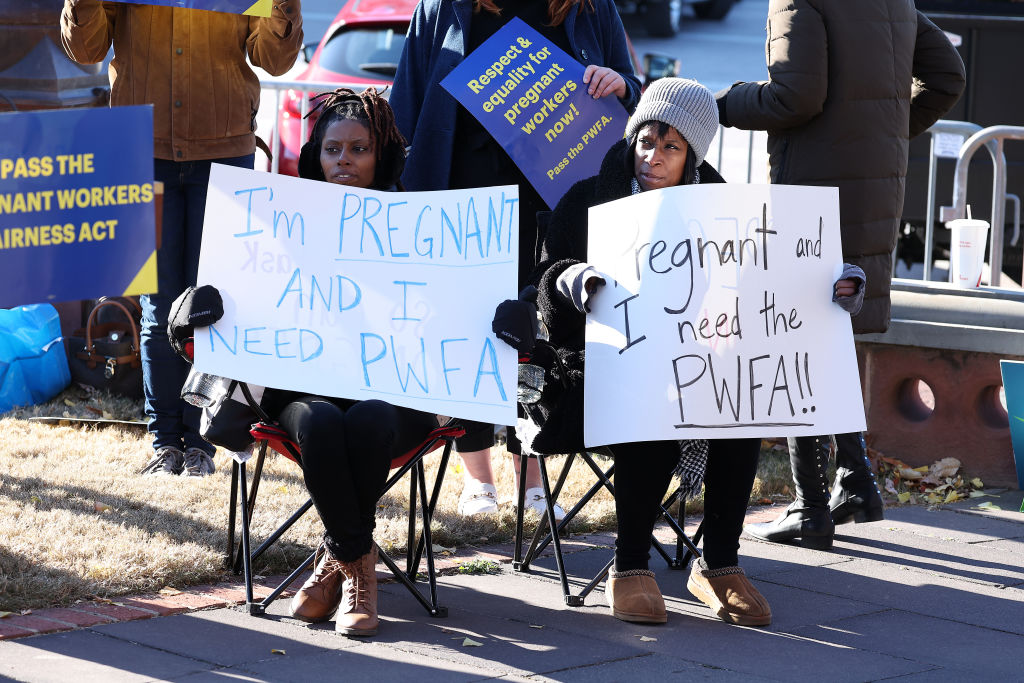It’s time for the Equal Employment Opportunity Commission and other government bodies to acknowledge the myriad ways perimenopause and menopause create barriers for working women.

The Pregnant Worker Fairness Act (PWFA) went into effect this summer, after President Biden signed it into law on Dec. 29, 2022. Following a decade-long campaign championed by A Better Balance and other advocates, the law is designed to protect pregnant workers’ health as they earn a living, support their families and contribute to the economy and public life.
In August, the federal Equal Employment Opportunity Commission (EEOC) issued a series of draft regulations for the PWFA’s implementation. The EEOC invited comments from the public, and received tens of thousands of letters in response. (The period for submissions closed Oct. 10.)
Among the EEOC regulations is a non-exhaustive list of medical conditions related to pregnancy and childbirth that employers are obligated to accommodate. These reflect the arc of employees’ reproductive lives and needs at various points as they navigate and manage fertility; undergo pregnancy, childbirth and the postpartum period, including lactation; and likely experience pregnancy loss or termination along the way.
One of the constants in this trajectory, of course, is menstruation—a biological function that continues month after month throughout the bulk of most women’s working lives. That the EEOC acknowledges this and includes menstruation as a medical condition that employers must is a notable first—and a meaningful advance for menstrual equity.
What kind of accommodations might this entail?
- Provision of freely available menstrual products in the workplace.
- Assurance of access to clean, safe and appropriate restroom facilities and breaks, which can be a challenge for myriad professions, from teachers to truck drivers.
- Options for telework and other workday flexibility.
The EEOC’s call-out of menstruation, though, is incomplete. It must be accompanied by an equally strong commitment to addressing employees in the throes of perimenopause and menopause.
Perimenopause is the period of time leading up to and one year past the menopause transition—when a person has their final menstrual period, which happens on average at age 51. Perimenopause can last a decade or more. For many, this life phase is marked by a vast range of disruptive symptoms—34 in total, from hot flashes and brain fog to migraines and sleep deprivation—and potentially serious medical conditions, triggered by fluctuating and falling estrogen levels.

Several recent studies document the myriad ways perimenopause and menopause create barriers for millions of working women and further underscore that women of color are disproportionately impacted. Among the findings:
- Menopause symptoms affect personal and company bottom lines, costing an estimated $1.8 billion in lost wages per year, according to Mayo Clinic calculations.
- A 2023 Bank of America report, “Break Through the Stigma: Menopause in the Workplace,” found that half of the women surveyed said menopause had a negative impact on their work life, with one in five women saying they have considered leaving their jobs or retiring early because they don’t get adequate support.
Admittedly, the list of examples of “related medical conditions” that the EEOC provides is non-exhaustive—and perimenopause and menopause could reasonably be construed to be implicit in the EEOC’s reference to “menstrual cycles.” But it is imperative that these be named explicitly. Failing to do so adds to the overall marginalization of perimenopausal and menopausal women—a marginalization that is echoed in the practice of medicine, in educational curricula, in the vast need for federally funded research, and in society writ large, as well as in the workplace.
Menopause also directly implicates pregnancy—the primary target of the PWFA. Women who give birth in their late 30s and early 40s can go right from postpartum to perimenopause; and symptoms of perimenopause, like erratic periods, can make unplanned pregnancies a possibility.
A handful of companies have begun to garner headlines for investing in menopause-related interventions, some of which can make a real difference—like benefits that ensure access to expert care, specialized telehealth services, and coverage for menopause hormone treatment. It is a rapidly emerging cause—a new menopause movement—and an important opportunity to expand the robust attention now paid to menstrual policy.
Like menstruation, like infertility, like the use of contraception, like abortion—all of which are specifically enumerated in the EEOC’s regulation—perimenopause and menopause are related to workers’ reproductive lives and capacity for pregnancy. The inclusion of these terms will provide valuable guidance to employers and the millions of affected workers.
Up next:
U.S. democracy is at a dangerous inflection point—from the demise of abortion rights, to a lack of pay equity and parental leave, to skyrocketing maternal mortality, and attacks on trans health. Left unchecked, these crises will lead to wider gaps in political participation and representation. For 50 years, Ms. has been forging feminist journalism—reporting, rebelling and truth-telling from the front-lines, championing the Equal Rights Amendment, and centering the stories of those most impacted. With all that’s at stake for equality, we are redoubling our commitment for the next 50 years. In turn, we need your help, Support Ms. today with a donation—any amount that is meaningful to you. For as little as $5 each month, you’ll receive the print magazine along with our e-newsletters, action alerts, and invitations to Ms. Studios events and podcasts. We are grateful for your loyalty and ferocity.





